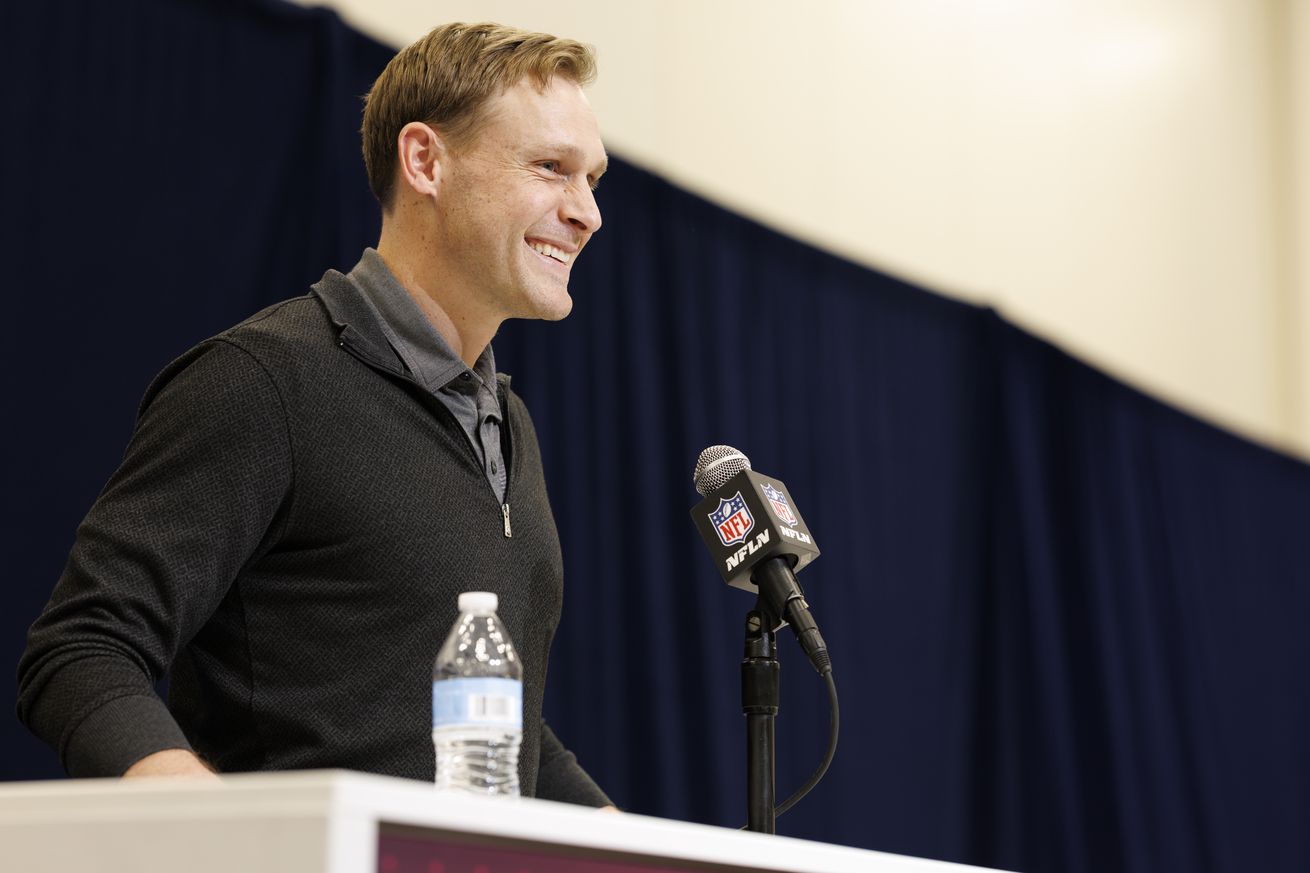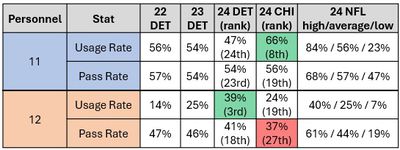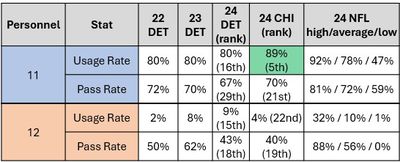
For the second offseason in a row, the Chicago Bears have brought in a new offensive coaching staff, and head coach and offensive playcaller Ben Johnson will be tasked with turning this talent into a cohesive and effective unit. Since Johnson spent three years as the play caller in Detroit, today I’ll dig into his data to see what we can learn that might translate to Chicago. I will focus primarily on his play-calling tendencies and less on the effectiveness of the offense, as effectiveness will depend significantly on personnel, which will be entirely different in Chicago.
In Part One of this two-part series, I explored Johnson’s playcalling trends by down and distance. Today, in part two, I want to explore how Johnson utilized different personnel groupings.
This data comes from Sumer Sports, and it looks solely at the listed position of players on the field and not where they are lined up. These groupings are commonly listed by two numbers, where the first is the number of running backs and the second is the number of tight ends. Since teams play five skill position players at a time, the number of wide receivers is then implied. The two most common groupings are 11 personnel (1 RB, 1 TE, 3 WR) and 12 (1 RB, 2 TE, 2 WR).
Early downs
The table below shows how frequently the Lions and Bears used and passed out of each grouping on 1st-2nd down in 2024, along with their ranks compared to the rest of the NFL.
- The pass rate shown is for % of plays in that particular formation, so for example the 2024 Lions were in 11 personnel for 47% of their 1st/2nd down plays and threw it on 54% of those plays. When they lined up in 12 personnel (39% of 1st/2nd down plays), they threw it 41% of the time.
- I wanted to look only at 1st and 2nd down first because these are more neutral settings, whereas personnel on 3rd/4th down will be far more dictated by yardage needed for a 1st.
- Values in the top 25% are highlighted in green, while those in the bottom 25% are red. Detroit’s data from 2022 and 2023 is included as well to see how much Johnson changed or stayed consistent from year to year.

A few thoughts:
- Detroit ran a bunch of 12 personnel (1 RB, 2 TE, 2 WRs) last year, and I’ve seen a lot of fans only look at that and say Johnson likes to run 2 TE sets. Looking at 2022 and 2023, however, paints a different picture, where Johnson’s personnel usage depends on, well, his personnel.
* In 2022, the Lions traded starting TE TJ Hockenson midway through the season, and barely had 1 TE worth playing. Consequently, they ran 2 TE sets at well below league-average rates.
* In 2023, the Lions added a capable starting TE in Sam LaPorta, and early 12 personnel rose to around league average. They still had 4 WRs playing meaningful roles, however, so 11 personnel remained around league average as well.
* In 2024, the Lions lost WR Josh Reynolds and had Brock Wright as a 4th-year TE2 they trusted, so they played fewer 3 WR sets and more 2 TE sets. The data suggests this is not necessarily something Ben Johnson will always do; it really depends on what his WR and TE depth chart looks like. After adding Colston Loveland in round 1 of the draft, I imagine we’ll see a heavy dose of 12 personnel in Chicago in 2025, but that will not necessarily stay the case in future years if the personnel does not dictate it.
Late Downs
Now let’s look at the same data for 3rd and 4th down, as shown in the table below.

A few thoughts:
- In general, we see a large shift to 11 personnel (3 WR) on late downs across the NFL, and Ben Johnson follows that trend. This is largely because offenses tend to be pass-happy on 3rd and 4th down, as we saw in down/distance trends in part 1, and more WRs on the field makes it easier to pass when the defense is expecting a pass.
- Once again, we see that Detroit doesn’t always default to having a lot of TEs on the field. Their 12 personnel rate was around average in 2023-24, when they had 2 capable TEs to play, but well below average when they were lacking at TE in 2022.
- Chicago was heavy in 11 personnel in all downs in 2024, which was largely because they had 3 WRs they had heavily invested in who rarely left the field. With Keenan Allen gone, I imagine the over-reliance on 11 personnel will no longer be an issue in 2025. This should help Caleb Williams, who threw a disproportionate amount of his 2025 passes to WRs despite being far more effective throwing to RB and TE.
- I am curious to see how Chicago deploys personnel in obvious passing situations; on the one hand, Colston Loveland could play a decent amount of slot WR if they want to keep 2 TE. On the other hand, Luther Burden could be a dangerous weapon as well, and maybe the Bears will add him as a 3rd WR and pull Cole Kmet off the field in these looks.
Lessons Learned
Ben Johnson said in his opening press conference that he would build his offense around the personnel he had, not just bring exactly what he did in Detroit to Chicago. We see clear evidence here of him doing just that already in Detroit, as his usage of different personnel groupings fluctuated quite a bit from year to year.
Contrary to popular narrative, Johnson does not consistently rely on 2 TE sets; that was only true in 1 of his 3 years as Detroit’s play caller, and was largely driven by having more confidence in the depth at TE than WR. The addition of Colston Loveland to Cole Kmet likely means we’ll see a lot of 2-TE sets in 2025, but if Cole Kmet leaves after that and Luther Burden develops nicely, the offense could easily shift to utilize more 3 WR looks in 2026 and beyond.